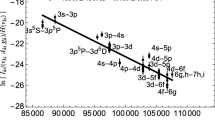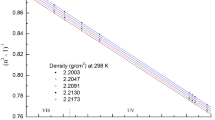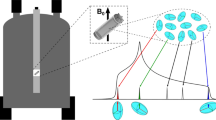Abstract
The paper presents an overview of experimental and theoretical results, which were obtained from the study of the dependence of Zeeman splitting of the vibrational-rotational lines of the 0–1 band of the nitric oxide molecule absorption spectra on the magnetic field magnitude. The experiments were performed at the Laboratory of Gas Lasers of P.N. Lebedev Physical Institute, Russian Academy of Sciences (FIAN). The method of laser magnetic resonance (LMR) with the use of a continuous-wave frequency-tunable CO laser were used to record the spectra. The theoretical analysis of LMR spectrograms was carried out at the Laboratory of Theoretical Spectroscopy of V.E. Zuev Institute of Atmospheric Optics, Siberian Branch, Russian Academy of Sciences (IAO SB RAS), where the numerical model was developed based on construction of the total effective Hamiltonian of the molecule accounting the interaction with an external magnetic field. The model allows calculation of LMR spectra under given conditions and description of the nonlinear dependence of splitting of rovibrational energy levels on the magnetic field magnitude. The comparison of calculated and experimental LMR spectrograms has shown that the numerical model adequately reproduces the positions of absorption peaks measured in a damped oscillating magnetic field.
Similar content being viewed by others
References
B. D. Belan, “Ozone in troposphere. 5. Gases as ozone precursors,” Opt. Atmos. Okeana 22 (3), 230–268 (2009).
S. Moncada, R. M. Palmer, and E. A. Higgs, “Nitric oxide: Physiology, pathophysiology, and pharmacology,” Pharmacol. Rev. 43 (2), 109–142 (1991).
A. Kaldor, W. B. Olson, and A. Maki, “Pollution monitor for nitric oxide: A laser device based on the zeeman modulation of absorption,” Science 176, 508–510 (1971).
P. A. Bonczyk and C. J. Ultee, “Nitric oxide detection by use of Zeeman-effect and CO laser,” Opt. Commun. 6 (2), 196–198 (1972).
P. Murtz, L. Menzel, W. Bloch, A. Hess, O. Michel, and W. Urban, “LMR spectroscopy: A new sensitive method for on-line recording of nitric oxide in breath,” J. Appl. Physiol. 86 (3), 1075–1080 (1999).
V. P. Gavrilenko, “Spectroscopic methods for measurements of magnetic fields in plasma,” in Encyclopaedia of Low-Temperature Plasma (Nauka, Moscow, 2000), pp. 556–558 [in Russian].
J. H. Van Vleck, “On s-type doubling and electron spin in the spectra of diatomic molecules,” Phys. Rev. 33 (1), 467–506 (1929).
J. H. Van Vleck, “The coupling of angular momentum vectors in molecules,” Rev. Mod. Phys. 23 (3), 213–227 (1951).
K. F. Freed, “Theory of the hyperfine structure of molecules: Application to 3 states of diatomic molecules intermediate between Hund’s cases (a) and (b),” J. Chem. Phys. 45 (11), 4214–4241 (1966).
W. L. Meerts and A. Dymanus, “The hyper fine ?-doubling spectra of 14N16O and 15N16O,” J. Mol. Spectrosc. 44 (2), 320–346 (1972).
L. Veseth, “Hund’s coupling case (c) in diatomic molecules. I. Theory,” J. Phys., 6 (8), 1473–1483 (1973).
R. N. Zare, A. L. Schmeltekopf, W. J. Harrop, and D. L. Albritton, “A direct approach for the reduction of diatomic spectra to molecular constants for the construction of RKR potentials,” J. Mol. Spectrosc. 46 (1), 37–66 (1973).
J. L. Femenias, “Etude des molecules diatomiques. Partie I. Hamiltonians,” Can. J. Phys. 55 (20), 1733–1774 (1977).
J. M. Brown, E. A. Colbourn, J. K. G. Watson, and F. D. Wayne, “An effective Hamiltonian for diatomic molecules. Ab initio calculations of parameters of HCl+,” J. Mol. Spectrosc. 74 (2), 294–318 (1979).
J.T. Hougen, The calculation of Rotational Energy Levels and Rotational Line Intensities in Diatomic Molecules (U.S. Government printing office, Washington, D.C., 1970), p. 49.
J. Brown and A. Carrington, Rotational Spectroscopy of Diatomic Molecules (Cambridge University Press, Cambridge, 2003).
R. Beringer and J. G. Castle, “Magnetic resonance absorption in nitric oxide,” Phys. Rev. 78 (5), 581–586 (1950).
M. Mizushima, J. T. Cox, and W. Gordy, “Zeeman effect in the rotational spectrum of NO,” Phys. Rev. 98 (4), 1034–1039 (1955).
R. Beringer, E. B. Rawson, and A. F. Henry, “Microwave resonance in nitric oxide: Lambda doubling and hyperfine structure,” Phys. Rev. 94 (2), 343–349 (1954).
M. Mizushima, K. M. Evenson, and J. S. Wells, “Laser magnetic resonance of the NO molecule using 78-, 79-, and 119-µm H2O laser lines,” Phys. Rev., 5 (5), 2276–2287 (1972).
K. W. Nill, F. A. Blum, A. R. Calawa, and T. C. Harman, “Observation of -doubling and Zeeman splitting in the fundamental infrared absorption band of nitric oxide,” Chem. Phys. Lett. 14 (2), 234–238 (1972).
H. J. Zeiger, F. A. Blum, and K. W. Nill, “Observation of strong nonlinearities in the high field Zeeman spectrum of NO at 1876 cm–1,” J. Chem. Phys. 59 (8), 3968–3970 (1973).
W. L. Meerts and L. Veseth, “The Zeeman spectrum of the NO molecule,” J. Mol. Spectrosc. 82 (1), 202–213 (1980).
K. M. Evenson, “Far-infrared laser magnetic resonance,” Faraday Discuss. Chem. Soc. 71 (1), 7–14 (1981).
A. R. W. McKellar, “Mid-infrared laser magnetic resonance spectroscopy,” Faraday Discuss. Chem. Soc. 71 (1), 63–76 (1981).
K. M. Evenson, R. D. Saykally, D. A. Jennigs, R. F. Carl, jr., and J. M. Brown, “Laser magnetic resonance in the far-infrared region,” in Application of Lasers in Spectroscopy and Photochemistry (Mir, Moscow, 1983) [in Russian].
L. Krasnoperov, “Application of laser magnetic resonance for the study of processes with participation of free radicals in the gaseous phase,” in Plasma Chemistry (Energoatomizdat, Moscow, 1987), Vol. 14, pp. 151–194 [in Russian].
J. M. Brown, “Infrared laser spectroscopy,” in Applied Laser Spectroscopy, Ed. by M. Inguscio and W. Demtroder (Plenum Press, 1995), pp. 189–214.
K. Hakuta and H. Uehara, “Laser Magnetic Resonance for the v = 1 0 transition of NO (2?3/2) by CO laser,” J. Mol. Spectrosc. 58 (2), 316–322 (1975).
R. M. Dale, J. W. C. Johns, A. R. W. McKellar, and M. Riggin, “High-resolution laser magnetic resonance and infrared-radiofrequency double-resonance spectroscopy of NO and Its Isotopes Near 5.4 µm,” J. Mol. Spectrosc. 67 (1–3), 440–458 (1977).
C. C. Lin and M. Mizushima, “Theory of the hyperfine structure of the NO molecule. II. Errata and some additionnal discussion,” Phys. Rev. 100 (6), 1726–1730 (1955).
Y. Liu, Y. Guo, H. Liu, J. Lin, X. Liu, G. Huang, F. Li, and J. Li, “On the nonlinearity of the Zeeman effect of NO in the moderate field by intracavity laser magnetic resonance at 1842 cm–1,” Phys. Lett., 272 (1), 80–85 (2000).
R. P. Andrusenko, A. A. Ionin, Yu. M. Klimachev, A. A. Kotkov, and A. Yu. Kozlov, “Nonlinear Zeeman splitting of nitric oxide spectral lines in magnetic field,” Proc. SPIE—Int. Soc. Opt. Eng. 6729, 672923 (2007).
K. Takazawa and H. Abe, “Electronic spectra of gaseous nitric oxide in magnetic fields up to 10 T,” J. Chem. Phys. 110 (19), 9492–9499 (1999).
K. Takazawa, H. Abe, and H. Wada, “Zeeman electronic spectra of gaseous NO in very high magnetic fields up to 25 T,” Chem. Phys. Lett. 329 (5), 405–411 (2000).
A. A. Ionin, Yu. M. Klimachev, A. Yu. Kozlov, and A. A. Kotkov, Preprint No. 18, FIAN (Physical Institute, Russian Academy of Sciences, 2009).
A. O. Dorokhov, Yu. M. Klimachev, A. A. Ionin, A. A. Kotkov, A. Yu. Kozlov, “Zeeman effect in the IR-region at NO molecule transitions,” in Proc. of MIFI Scientific Session (Moscow, MIFI, 2009), Vol. 4, pp. 171–174.[in Russian].
A. A. Ionin, Yu. M. Klimachev, A. Yu. Kozlov, and A. A. Kotkov, “Mid-IR Zeeman spectrum of nitric oxide molecules in a strong magnetic field,” J. Phys., 44, 025403 (2011).
Yu. G. Borkov, A. A. Ionin, I. O. Kinyaevskii, Yu. M. Klimachev, A. Yu. Kozlov, A. A. Kotkov, and O. N. Sulakshina, “Study of the Aeeman effct in the IR-spectrum of NO molecule,” in Proc. of the XX Intern. Symp. “Atmospheric and Oceanic Optics. Atmospheric Physics” (Publishing House of IAO SB RAS, Tomsk, 2014) [in Russian].
Yu. G. Borkov, A. A. Ionin, Yu. M. Klimachev, I. O. Kinyaevskiy, A. A. Kotkov, A. Yu. Kozlov, and O. N. Sulakshina. http://ocsciemates/EPS2014PAP/ pdf/P1.121pdf.
Yu. G. Borkov, A. A. Ionin, Yu. M. Klimachev, I. O. Kinyaevskiy, A. A. Kotkov, A. Yu. Kozlov, and O. N. Sulakshina, “Zeeman effect treatment in the infrared spectrum of the nitric oxide molecule,” Proc. SPIE—Int. Soc. Opt. Eng. 9292 (5), 929207 (2014).
S. Vetoshkin, A. Ionin, Yu. Klimachev, A. Kotkov, A. Kozlov, O. Rulev, L. Seleznev, and D. Sinitsyn, “Multiline laser probing for active media CO:He, CO:N2, and CO:O2 in wide-aperture pulsed amplifier,” J. Russian Laser Res. 27 (1), 33–69 (2006).
H. E. Radford, “Microwave Zeeman effect of free hydroxyl radicals,” Phys. Rev. 122 (1), 114–130 (1961).
A. Schadee, “On the Zeeman effect in electronic transitions of diatomic molecules,” J. Quant. Spectrosc. Radiat. Transfer 19 (5), 517–531 (1978).
A. A. Ramos and J. T. Bueno, “Theory and modeling of the Zeeman and Paschen–Back effects in molecular lines,” Astrophys. J. 636 (1), 548–563 (2006).
O. N. Sulakshina, “Theoretical treatment of the vibrational-rotational spectra of stable diatomic radicals in the 2? state,” Atmos. Ocean. Opt. 17 (11), 774–782 (2004).
C. Amiot, J. P. Maillard, and J. Chauville, “Fourier spectroscopy of the OD infrared spectrum. Merge of electronic, vibration-rotation, and microwave spectroscopic data,” J. Mol. Spectrosc. 87 (1), 196–218 (1981).
H. Schall, J. A. Gray, M. Dulick, and R. W. Field, “Sub-Doppler Zeeman spectroscopy of the CeO molecule,” J. Chem. Phys. 85 (2), 751–762 (1986).
W. Herrmann, W. Rohrbeck, and W. Urban, “Line shape analysis for Zeeman modulation spectroscopy,” Appl. Phys. 22 (1), 71–75 (1980).
L. S. Rothman, I. E. Gordon, Y. Babikov, A. Barbe, C. D. Benner, P. F. Bernath, M. Birk, L. Bizzocchi, V. Boudon, L. R. Brown, A. Campargue, K. Chance, E. Cohen, L. H. Coudert, V. M. Devi, B. J. Drouin, A. J.-M. Flaud, R. R. Gamache, J. J. Harrison, J.-M. Hartmann, C. Hill, J. T. Hodges, D. Jacquemart, A. Jolly, J. Lamouroux, R. J. Le Roy, G. Li, D. A. Long, O. M. Lyulin, C. J. Mackie, S. T. Massie, S. Mikhailenko, H. S. P. Muller, O. V. Naumenko, A. V. Nikitin, J. Orphal, V. Perevalov, A. Perrin, E. Polovtseva, C. Richard, M. A. H. Smith, E. Starikova, K. Sung, S. Tashkun, J. Tennyson, G. C. Toon, V. Tyuterev, and G. Wagner, “The HITRAN 2012 molecular spectroscopic database,” J. Quant. Spectrosc. Radiat. Transfer 130 (1), 4–50 (2012).
Author information
Authors and Affiliations
Corresponding author
Additional information
Original Russian Text © Yu.G. Borkov, Yu.M. Klimachev, O.N. Sulakshina, 2015, published in Optika Atmosfery i Okeana.
Rights and permissions
About this article
Cite this article
Borkov, Y.G., Klimachev, Y.M. & Sulakshina, O.N. Dependence of Zeeman splitting of spectral lines on the magnetic field magnitude for NO molecule. Atmos Ocean Opt 29, 103–118 (2016). https://doi.org/10.1134/S1024856016020044
Received:
Published:
Issue Date:
DOI: https://doi.org/10.1134/S1024856016020044




